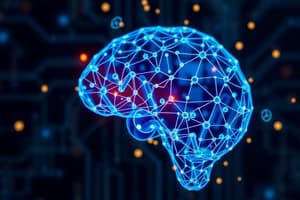Podcast
Questions and Answers
What is the primary objective of problem-solving activity?
What is the primary objective of problem-solving activity?
- To determine the best course of action
- To analyze complex data sets
- To find sequences of actions that lead to solutions (correct)
- To evaluate past decisions
Which of the following best describes the outcome sought in problem-solving?
Which of the following best describes the outcome sought in problem-solving?
- Achieving desirable states of the environment (correct)
- Reducing the time taken to solve problems
- Minimizing errors in judgment
- Reaching higher efficiency in processes
Which approach is not associated with problem-solving?
Which approach is not associated with problem-solving?
- Exploring multiple strategies for action
- Identifying potential solutions
- Avoiding any analysis of the situation (correct)
- Defining the problem clearly
In problem-solving, what is the significance of 'sequences of action'?
In problem-solving, what is the significance of 'sequences of action'?
What is a common misconception about problem-solving?
What is a common misconception about problem-solving?
What characterizes non-linear data structures?
What characterizes non-linear data structures?
What is the main objective in AI problem-solving?
What is the main objective in AI problem-solving?
Which of the following is true about traversing non-linear data structures?
Which of the following is true about traversing non-linear data structures?
In the context of state space search, what does the term 'initial state' refer to?
In the context of state space search, what does the term 'initial state' refer to?
Why can't all elements of a non-linear data structure be traversed in a single run?
Why can't all elements of a non-linear data structure be traversed in a single run?
What is meant by the 'goal state' in state space search?
What is meant by the 'goal state' in state space search?
Non-linear data structures differ from linear data structures in that they:
Non-linear data structures differ from linear data structures in that they:
Which statement about non-linear data structures is incorrect?
Which statement about non-linear data structures is incorrect?
Which of the following best describes the state space search process?
Which of the following best describes the state space search process?
Which of these statements is NOT true about AI problem-solving?
Which of these statements is NOT true about AI problem-solving?
What characterizes a disconnected graph?
What characterizes a disconnected graph?
In a disconnected graph, which of the following statements is true?
In a disconnected graph, which of the following statements is true?
Which of these scenarios exemplifies a disconnected graph?
Which of these scenarios exemplifies a disconnected graph?
Which of the following best describes nodes in a disconnected graph?
Which of the following best describes nodes in a disconnected graph?
If a graph is disconnected, what does it imply about its structure?
If a graph is disconnected, what does it imply about its structure?
What is defined as the topmost node of a tree?
What is defined as the topmost node of a tree?
Which of the following characteristics is true for a root node?
Which of the following characteristics is true for a root node?
In a tree structure, what is a node that has no children called?
In a tree structure, what is a node that has no children called?
Which option best describes the relationship between the root node and other nodes in a tree?
Which option best describes the relationship between the root node and other nodes in a tree?
Which of the following statements about the root node is false?
Which of the following statements about the root node is false?
What is a unique characteristic of a tree in graph theory?
What is a unique characteristic of a tree in graph theory?
How does the structure of nodes in a tree differ from that in a general graph?
How does the structure of nodes in a tree differ from that in a general graph?
Which of the following statements is correct regarding the relationship between nodes and edges in a tree?
Which of the following statements is correct regarding the relationship between nodes and edges in a tree?
Which of the following is true about nodes in a general graph as compared to a tree?
Which of the following is true about nodes in a general graph as compared to a tree?
What distinguishes a tree from other types of graphs?
What distinguishes a tree from other types of graphs?
Flashcards
Problem Solving
Problem Solving
The process of identifying and implementing a series of actions to achieve a desired outcome.
Desirable State
Desirable State
The desired outcome or goal that is being sought in problem solving.
Sequences of Action
Sequences of Action
The steps or actions taken to move closer to the desired state.
Environment
Environment
Signup and view all the flashcards
Solutions
Solutions
Signup and view all the flashcards
Goal State
Goal State
Signup and view all the flashcards
Initial State
Initial State
Signup and view all the flashcards
State Space Search
State Space Search
Signup and view all the flashcards
Solution Path
Solution Path
Signup and view all the flashcards
Objective of AI problem-solving
Objective of AI problem-solving
Signup and view all the flashcards
Non-linear Data Structures
Non-linear Data Structures
Signup and view all the flashcards
Multi-level Hierarchy
Multi-level Hierarchy
Signup and view all the flashcards
Non-sequential Traversal
Non-sequential Traversal
Signup and view all the flashcards
Examples of Non-linear Data Structures
Examples of Non-linear Data Structures
Signup and view all the flashcards
Applications of Non-linear Data Structures
Applications of Non-linear Data Structures
Signup and view all the flashcards
Disconnected Graph
Disconnected Graph
Signup and view all the flashcards
Isolated Node
Isolated Node
Signup and view all the flashcards
Connected Component
Connected Component
Signup and view all the flashcards
Edge Connectivity
Edge Connectivity
Signup and view all the flashcards
Connected Graph
Connected Graph
Signup and view all the flashcards
Vertices/Nodes
Vertices/Nodes
Signup and view all the flashcards
Edges
Edges
Signup and view all the flashcards
Root (Tree)
Root (Tree)
Signup and view all the flashcards
Tree
Tree
Signup and view all the flashcards
Children (Tree Node)
Children (Tree Node)
Signup and view all the flashcards
Root Node
Root Node
Signup and view all the flashcards
Parent Node
Parent Node
Signup and view all the flashcards
Child Node
Child Node
Signup and view all the flashcards
Leaf Node
Leaf Node
Signup and view all the flashcards
Siblings
Siblings
Signup and view all the flashcards
Study Notes
Artificial Intelligence (AI) - Problem Solving and Search Methodologies
- Problem Solving: Finding sequences of actions that lead to desired states (solutions) in an environment.
- Informed/Uninformed Search: Agents can be either informed (have knowledge about how to search) or uninformed (lacking such knowledge).
- Problem Formulation: Key components include initial state, goal state, operators (actions), state space (all reachable states), goal test, cost (moving between states), and heuristics (search guidance).
- Evolutionary Computation: A sub-field of AI used for complex optimization problems. Involves using computational models that apply evolutionary processes (inspired by biological evolution). Examples include genetic algorithms, evolutionary programming, and swarm intelligence (like ant colony optimization or particle swarm optimization).
Problem Solving Processes
- Define the problem: Clearly state the issue.
- Analyze the problem: Examine the problem's components and constraints.
- Identify possible solutions: Brainstorm potential solutions.
- Choose the optimal solution: Select the most effective solution.
- Implementation: Execute the chosen solution.
Types of Search Algorithms
- Uninformed Search: No additional information besides how to traverse a tree. Examples: Breadth-First Search, Depth-First Search, Uniform Cost Search.
- Informed Search: Uses information about the goal state to improve search efficiency. Examples: A* Search, Greedy Search, Graph Search.
Difference between Informed and Uninformed Search
- Uninformed Search: Based on blind search methods. No knowledge of the goal state or potential solutions. Relies purely on the steps to traverse the possible solutions. Requires more search time. High cost.
- Informed Search: Uses available knowledge of the goal state to accelerate the search process. Finds solutions faster. Lower cost.
Data Structures
- Linear Data Structures: Elements arranged sequentially. Single level. Examples: Array, Stack, Queue, Linked List
- Non-linear Data Structures: Elements not necessarily arranged in a sequence. Multiple levels. Examples: Graphs, Trees
Linear Data Structures
- Array: Basic data type. Stores elements in contiguous memory locations. Quick access to elements using numerical index numbers.
- Linked List: Elements not stored contiguously. Pointer system helps keep track of element position in the list.
- Stack: Follows LIFO (Last-In, First-Out) principle. Pushing involves adding to the top of the stack. Popping removes data from the top.
- Queue: FIFO (First-In, First-Out) principle. Data is accessed from the front of the queue while new data is added to the rear.
Non-linear Data Structures
- Graph: Data structure with nodes or vertices and edges connecting them. The edges define relationships between nodes. Useful for representing complex relationships and interconnected data. Can include different types of connections (directed/undirected, weighted).
- Tree: Hierarchical data structure where nodes are connected by edges to form a parent-child relationship. Rooted. Commonly used in applications where hierarchical relationships are needed, like file systems. Includes root, leaves, and levels. Contains specific terminology like ancestor, descendants, sibling, and subtree.
Traversal vs. Search
- Traversal: Systematic method of visiting all nodes in a tree. May print node values.
- Search: May or may not visit all nodes in a graph. Systematic exploration. Efficient if knowledge of goal is available.
Studying That Suits You
Use AI to generate personalized quizzes and flashcards to suit your learning preferences.
Related Documents
Description
This quiz tests your knowledge on AI problem-solving techniques and the characteristics of non-linear data structures. You will explore important concepts such as state space search, sequences of action, and common misconceptions. Assess your understanding and enhance your skills in this critical area of computer science.




